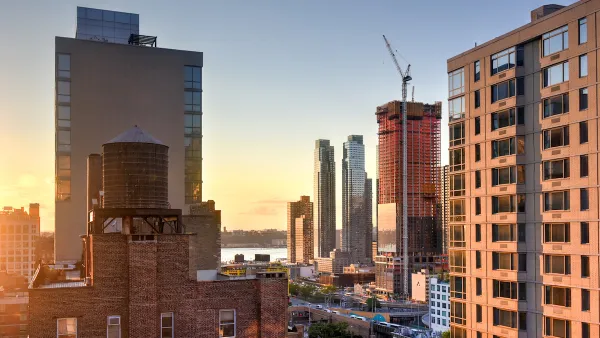Edward L. Glaeser looks back on the boom towns of yore and warns that, without a little balance, the dominance of finance in New York could spell trouble.
For a city of over 8 million people, an astonishing portion of New York's wealth is earned in just one, curiously abstract place: financial services. Concentrated predominantly in Manhattan, the financial industry accounted for 44 percent of all wages earned in the borough in 2008. With that level of economic concentration, Glaeser cautions, New York may expose itself to the kind of vulnerability that hollowed out the manufacturing-heavy cities of the Rust Belt – Detroit, Cleveland, and Pittsburgh, to name a few.
Of course, it wasn't always this way. Even with its earlier cash cows – first sugar refining, then printing and publishing, and finally garment manufacture – the city always kept economically diverse. At the height of the garment industry's success, right around 1950, it employed only 8 percent of all New Yorkers. Weighing in at only 16 percent of total employment in Manhattan, Glaeser notes that the financial sector may not seem as dominant at first blush. "Still, the sheer size of the financiers' salaries means that the success of other industries, from the restaurant business to real estate, is tied closely to the success of finance."
Glaeser likens the circa-1970s innovations in the financial market to Henry Ford's transformation of industry at the turn of the century, attributing "the troubled city's resurgence" to "quantitative approaches to evaluating risk, ever-larger leveraged buyouts, [and] the securitization revolution."
There are ample theoretical arguments on both sides of the aisle, arguing either that concentrating an industry in one tight space catalyzes the production of knowledge, or that innovation founders in the absence of diversity. "At its extreme, this [latter] view predicts that Silicon Valley will eventually resemble Detroit. In the short run, industrial concentration can lead to rapid leaps along a technological path. But progress along that path will eventually grow slower and yield diminishing returns, since an industrial monoculture will not encourage radically new discoveries."
But what can the city do to steer the economy in the right direction? Glaeser doesn't advocate stifling finance, but rather removing the hurdles that stand in the way of budding enterprise. In particular, he points to controlling property values and income taxes, both of which can be onerous to innovators in promising-but-risky fields like applied science.
"Building on a long, narrow island will always be expensive, but it could be less expensive if there were fewer rules deterring new construction. The city is currently considering 'upzoning' the area around Grand Central Terminal to allow bigger, denser buildings, which could slow price growth for the financial-sector firms located there. Increasing the supply of top-tier space for financiers would indirectly aid other sectors as well, by limiting the competition for less prime real estate elsewhere in New York."
FULL STORY: Wall Street Isn’t Enough

Analysis: Cybertruck Fatality Rate Far Exceeds That of Ford Pinto
The Tesla Cybertruck was recalled seven times last year.

National Parks Layoffs Will Cause Communities to Lose Billions
Thousands of essential park workers were laid off this week, just before the busy spring break season.

Retro-silient?: America’s First “Eco-burb,” The Woodlands Turns 50
A master-planned community north of Houston offers lessons on green infrastructure and resilient design, but falls short of its founder’s lofty affordability and walkability goals.

Test News Post 1
This is a summary

Analysis: Cybertruck Fatality Rate Far Exceeds That of Ford Pinto
The Tesla Cybertruck was recalled seven times last year.

Test News Headline 46
Test for the image on the front page.
Urban Design for Planners 1: Software Tools
This six-course series explores essential urban design concepts using open source software and equips planners with the tools they need to participate fully in the urban design process.
Planning for Universal Design
Learn the tools for implementing Universal Design in planning regulations.
EMC Planning Group, Inc.
Planetizen
Planetizen
Mpact (formerly Rail~Volution)
Great Falls Development Authority, Inc.
HUDs Office of Policy Development and Research
NYU Wagner Graduate School of Public Service




























